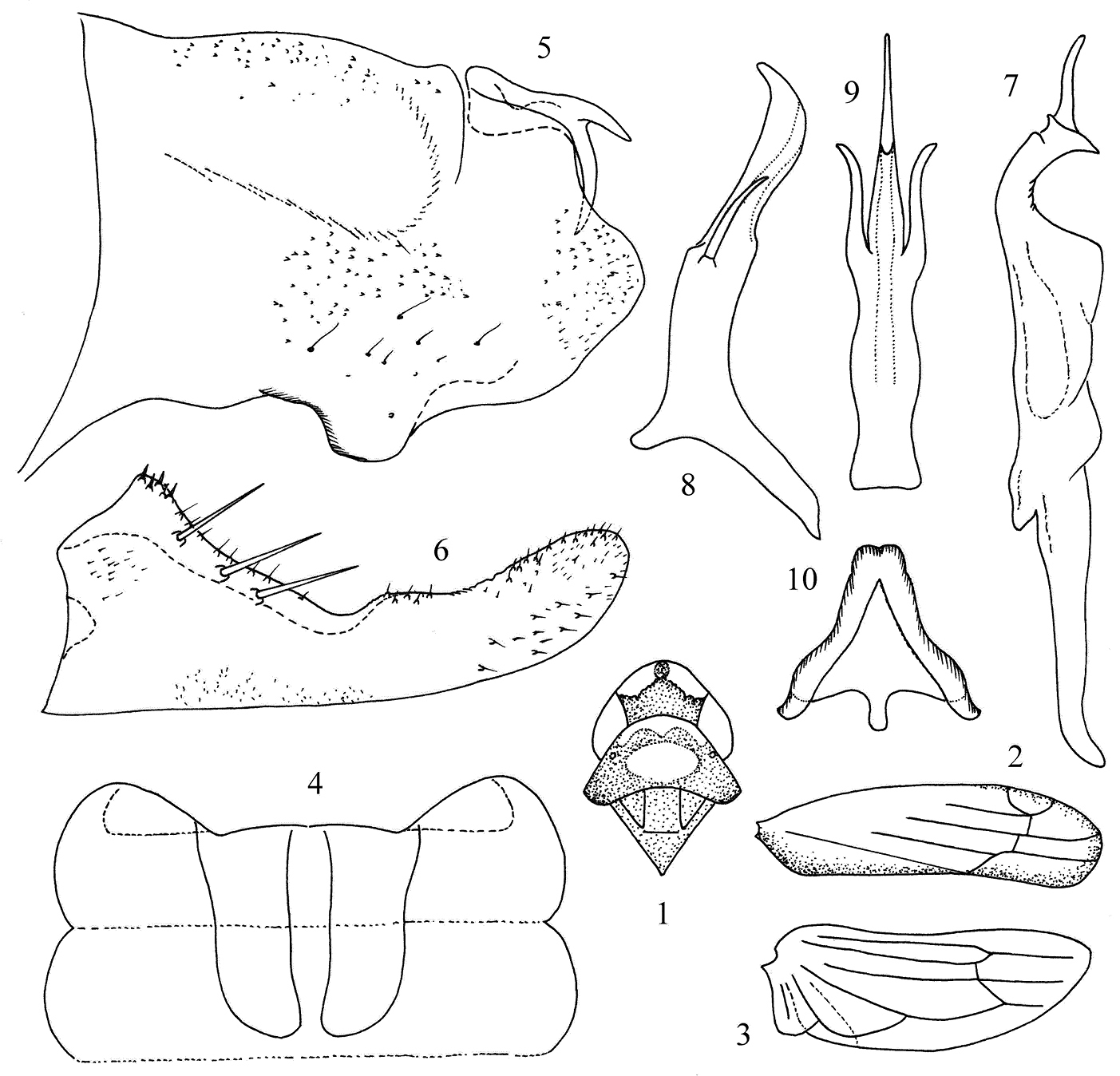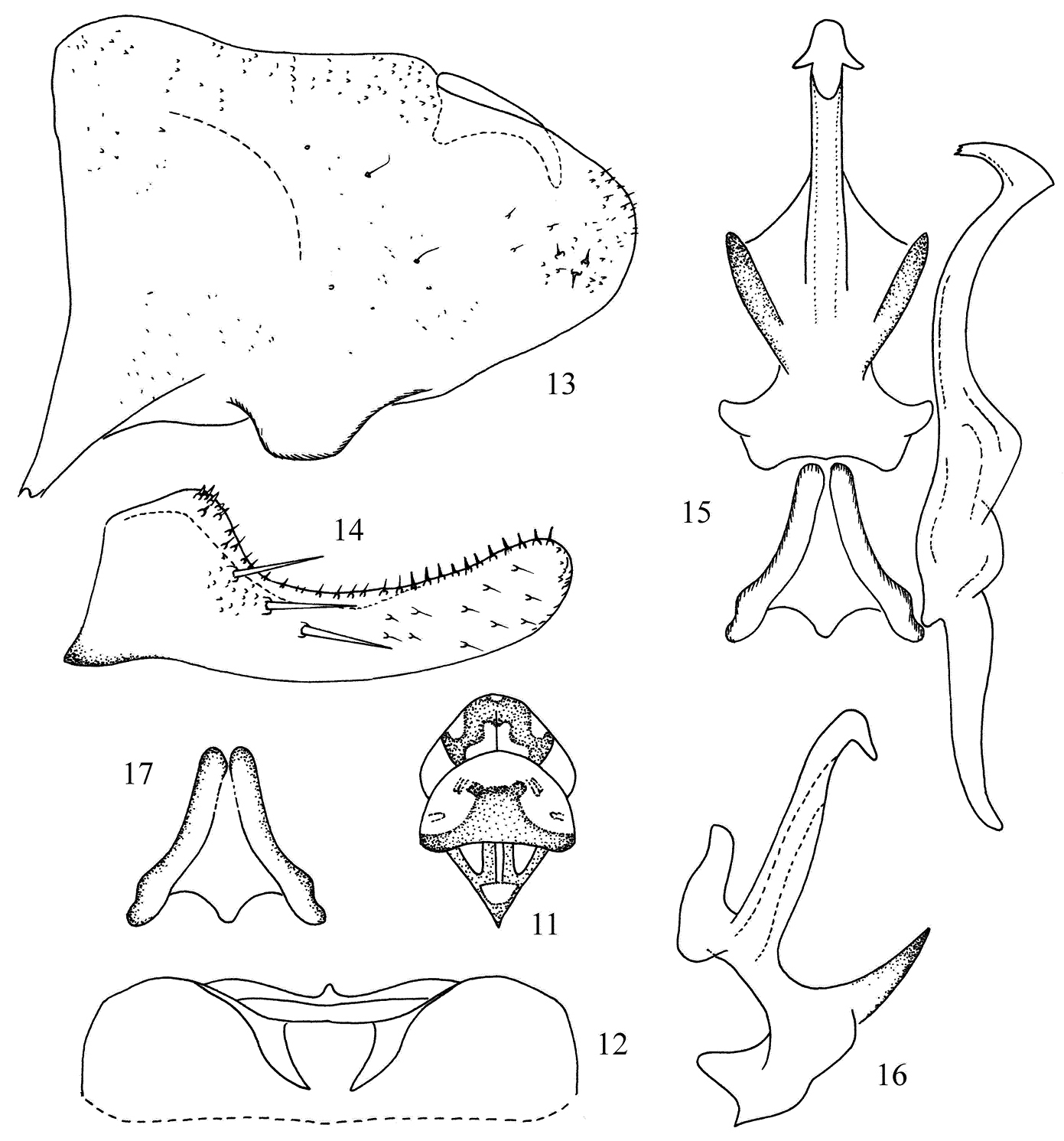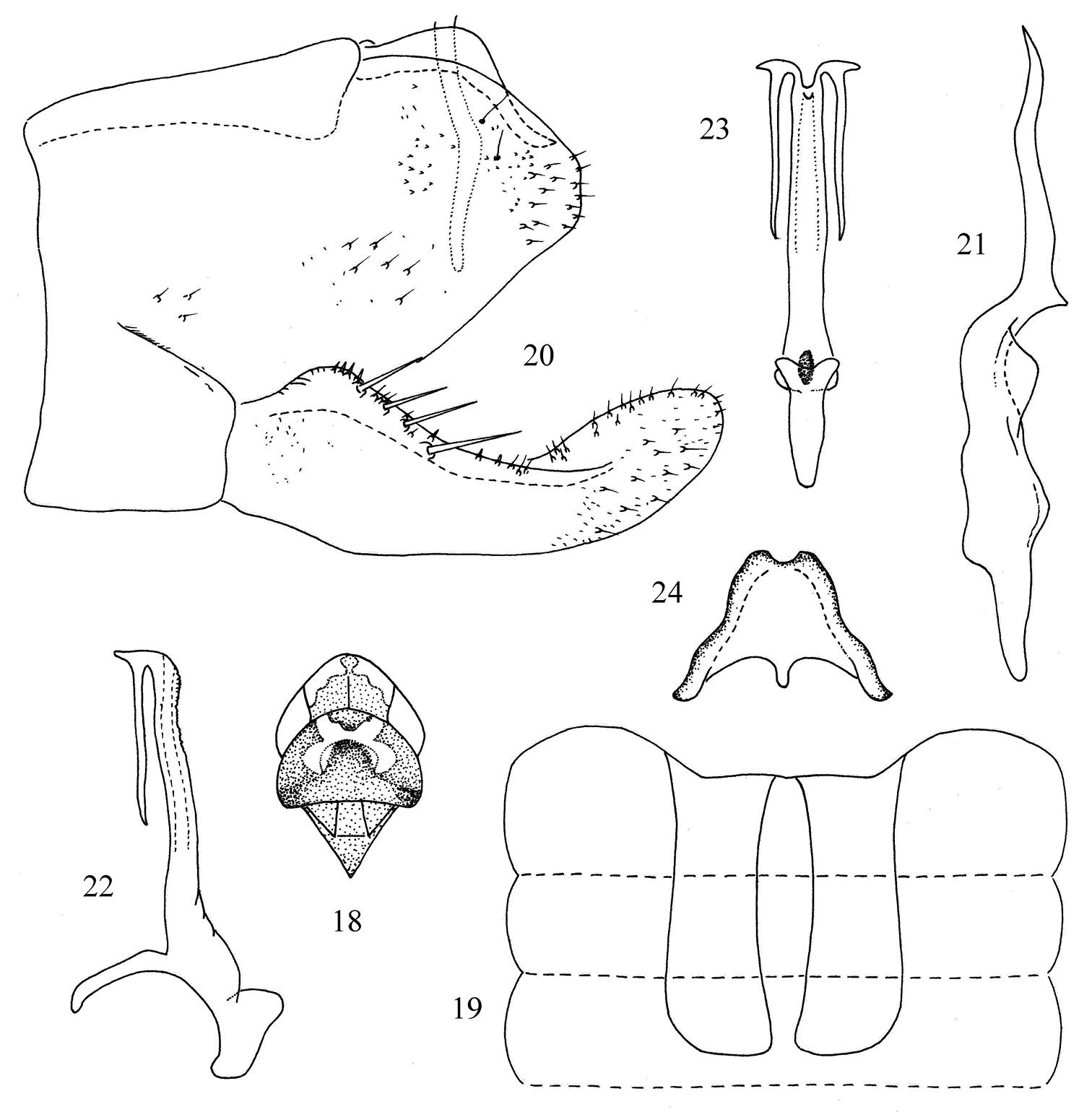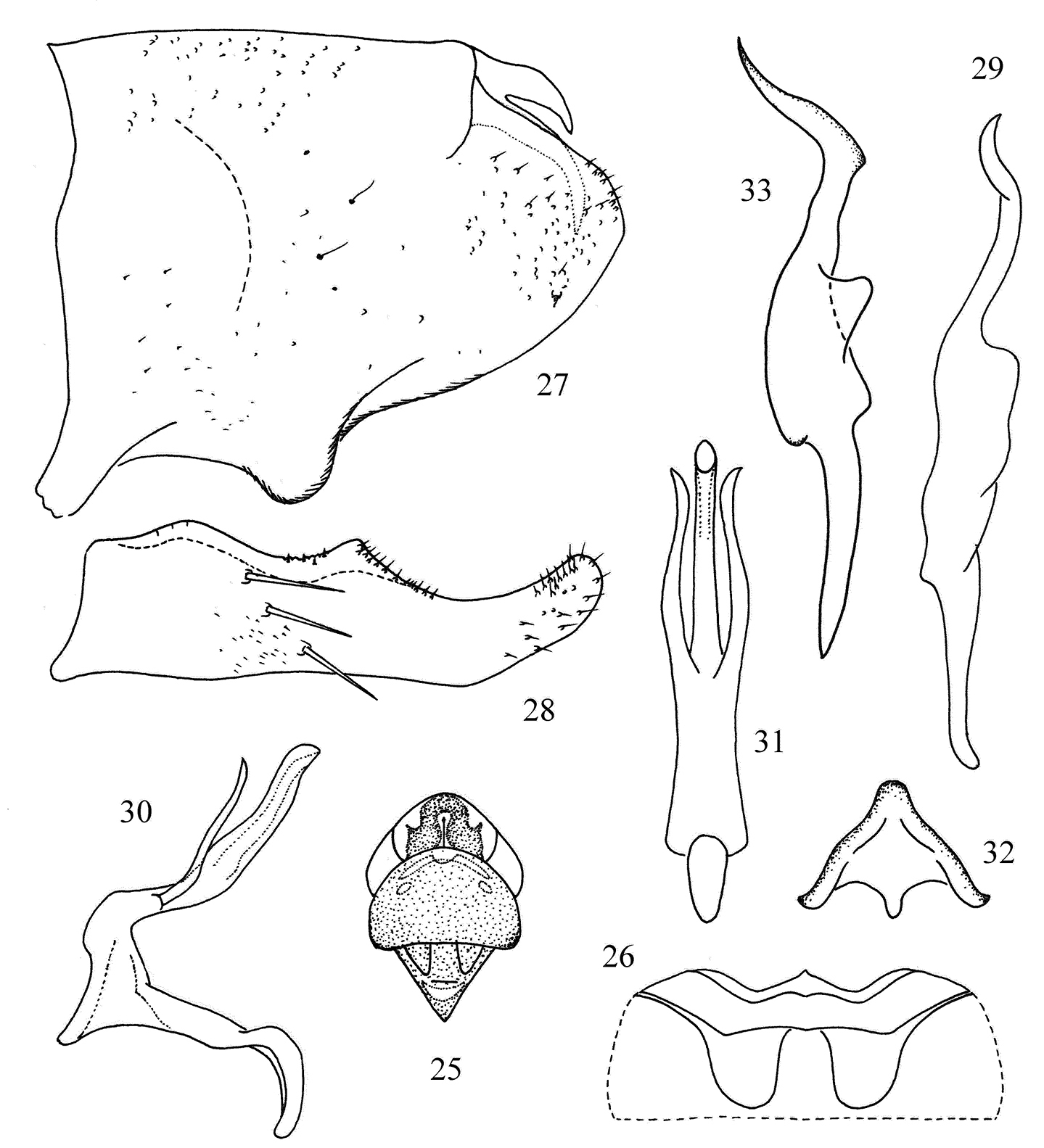






(C) 2012 Yuehua Song. This is an open access article distributed under the terms of the Creative Commons Attribution License 3.0 (CC-BY), which permits unrestricted use, distribution, and reproduction in any medium, provided the original author and source are credited.
For reference, use of the paginated PDF or printed version of this article is recommended.
In the present paper, four new species, Kapsa acuminata, Kapsa quadrispina, Kapsa puerensis and Kapsa yanheensis spp. n. from southwest China are described and illustrated, and a key to the species recorded from China is provided.
Morphology, taxonomy, Erythroneurini
The leafhopper genus Kapsa
http://species-id.net/wiki/Kapsa
Typhlocyba furcifrons Jacobi, 1941
Dorsum beige, yellow or white. Vertex unicolorous or with pair of preapical spots or with large median apical spot. Scutellum pale with or without dark lateral triangles or entirely dark.
Head narrower than pronotum, fore margin weakly produced, broadly rounded. Forewing with outer apical cell short; hind wing submarginal vein not extended to wing apex.
Male pygofer lobe with oblique dorsolateral internal ridge, usually with sparse long fine setae on lateral surface; dorsal appendage movably articulated; ventral appendages absent. Subgenital plates with 2-6 basal macrosetae. Style apex with extension; preapical lobe prominent. Connective Y-shaped, with central lobe well developed. Aedeagus with or without processes, gonopore apical on ventral surface. Anal tube usual with basal processes.
The genus is similar Tautoneura Anufriev, 1969 externally (body slim, dorsum yellow or white, head and face narrow) but the forewing lacks the red dots found in Tautoneura. It also differs in having the male pygofer lobe with basolateral setae not distinctly enlarged, and the pygofer without ventral appendages. The genus is also similar to Empoascanara Distant, 1918 in the male genitalia although differing in having the subgenital plate microsetae on the dorsal margin not in groups and the style with a 2nd extension. It differs externally from Emopoascanara in its narrower head.
India; Nepal; Sri Lanka; China (Taiwan, Sichuan, Guizhou, Yunnan); Vietnam; Indonesia; New Guinea.
| 1 | Aedeagus with processes (Figs 9, 15, 23, 31) | 2 |
| – | Aedeagus without processes | 6 |
| 2 | Aedeagus with both basal and apical processes (Figs 15, 16) | Kapsa quadrispinasp. n. |
| – | Aedeagus either with basal processes or apical processes (Figs 9, 23, 31) | 3 |
| 3 | Pygofer with dorsal appendage bifurcate (Figs 5, 27) | 4 |
| – | Pygofer with dorsal appendage not bifurcate (Figs 13, 20) | 5 |
| 4 | Aedeagus with pereatrium and basal processes moderately long (Fig. 8) | Kapsa acuminata sp. n. |
| – | Aedeagus with preatrium and basal processes long (Fig. 30) | Kapsa yanheensis sp. n. |
| 5 | Aedeagus with processes placed apically on shaft, bifurcate near base (Figs 22, 23) | Kapsa puerensis sp. n. |
| – | Aedeagus with processes placed medially on shaft, not bifurcate | Kapsa biprocessa Song & Li |
| 6 | Aedeagus with dorsal apodeme short and small, not expanded in lateral view | Kapsa fangxianga Song & Li |
| – | Aedeagus with dorsal apodeme large, greatly expanded in lateral view | 7 |
| 7 | Pygofer dorsal appendage short, distinctly expanded at base | Kapsa diasonica Chiang & Knight |
| – | Pygofer dorsal appendage long, not distinctly expanded at base | 8 |
| 8 | Gonopore long (as in Fig. 9) | 9 |
| – | Gonopore short (as in Figs 22, 23, 30, 31) | 10 |
| 9 | Aedeagus with preatrium short | Kapsa arca Song & Li |
| – | Aedeagus with preatrium extremely long | Kapsa elscinta Chiang & Knight |
| 10 | Aedeagal shaft slender and sinuate | Kapsa dolka Dworakowska |
| – | Aedeagal shaft broad and straight | Kapsa suaoensis Chiang & Knight |
urn:lsid:zoobank.org:act:C3213F38-E901-470D-BF1C-0A6D218E5B5F
http://species-id.net/wiki/Kapsa_acuminata
Figures 1–10Dorsum beige. Vertex with pair of milky yellow preapical spots; pronotum with anterior margin and median area ivory-white (Fig. 1). Forewing brownish yellow along inner and outer margin (Fig. 2).
Abdominal apodemes nearly reaching posterior margin of 4th sternite (Fig. 4).
Male pygofer with dorsal appendage bifurcate far from base (Fig. 5). Anal tube processes indistinct. Subgenital plate long, extended beyond pygofer apex, with three long macrosetae in oblique row (Fig. 6). Style elongate, preapical lobe distinct (Fig. 7). Connective Y-shaped with central lobe broad and arms short (Fig. 10). Aedeagal shaft laterally compressed distally, tapered to acute apex in ventral view (Fig. 9), with pair of processes at mid-length; gonopore long; preatrium long and dorsal apodeme short (Figs 8, 9).
Body length males 2.3~2.5 mm.
Holotype, male, China: Guizhou Province, Mayanghe National Nature Reserve, 4 Oct. 2007, coll. Yue-hua Song. Paratypes: five males, same date as holotype.
The new species is similar to Kapsa biprocessa Song & Li (2008), but can be distinguished mainly by the aedeagus with pair of basal processes close to shaft; the more acute apex of shaft in ventral view with the gonopore longer (Figs 8, 9).
The specific epithet is derived from the Latin word “acuminata” which refers to the acuminate apex of aedeagus in ventral view.
Kapsa acuminata sp. n. 1 Head and thorax, dorsal view 2 Forewing 3 Hind wing 4 Abdominal apodemes 5 Pygofer lobe, lateral view 6 Subgenital plate 7 Style 8 Aedeagus, lateral view 9 Aedeagus, ventral view 10 Connective
urn:lsid:zoobank.org:act:2C2E709E-3CC3-4DED-A4E4-CD274D604A76
http://species-id.net/wiki/Kapsa_quadrispina
Figures 11–17Dorsum beige. Vertex with large median apical spot, brownish yellow; pronotum with median area and posterior margin, brownish yellow; scutellum with basal triangles and T-shaped streak medially, milky yellow (Fig. 11). Forewing with brochosome field orange yellow.
Abdominal apodemes slim, not exceeding 3rd sternite (Fig. 12).
Male pygofer lobe with dorsal appendage slightly curved downward in lateral view (Fig. 13). Anal tube with processes very short, indistinct. Subgenital plate with three long macrosetae in oblique row and row of short stout setae along upper margin (Fig. 14). Style elongate, with apex slightly expanded; preapical lobe prominent (Fig. 15). Connective Y-shaped with central lobe broad and arms short (Fig. 17). Aedeagus with pair of basal atrial processes, well separated from shaft, the latter with pair of short apical processes; gonopore moderately long; preatrium broad and dorsal apodeme short (Figs 15, 16).
Body length male 2.8 mm.
Holotype, male, China: Guizhou Province, Mayanghe National Nature Reserve, at light, 30 Sep. 2007, coll. Yue-hua Song. Paratypes: two females, same date as holotype.
The new species is similar to Kapsa distalis Sohi & Mann (1992), but the aedeagus has a pair of atrial processes and apical processes (Figs 15, 16) and the dorsal pygofer appendage is not apically bifurcate (Fig. 13).
The specific name is derived from the Latin prefix “quadri-” and the Latin word “spina”, referring to the aedeagus with four processes (Figs. 15, 16).
Kapsa quadrispina sp. n. 11 Head and thorax, dorsal view 12 Abdominal apodemes 13 Pygofer lobe, lateral view 14 Subgenital plate 15 Style, aedeagus and connective, ventral view 16 Aedeagus, lateral view 17 Connective.
urn:lsid:zoobank.org:act:EBB34F64-A357-4FB2-94A9-206E38FBC92E
http://species-id.net/wiki/Kapsa_puerensis
Figures 18–24Dorsum brownish yellow. Pair of preapical patches on vertex and medial area of pronotum, milky yellow (Fig. 18). Forewing beige.
Abdominal apodemes large, broad, extended to 5th sternite (Fig. 19).
Male pygofer with dorsal appendage expanded medially and tapering towards apex (Fig. 20). Anal tube with basal processes long, slightly curved (Fig. 20). Subgenital plate with four long macrosetae in oblique row and row of short rigid setae along upper margin (Fig. 20). Style not long, apex extremely elongate, little less than half length of style; preapical lobe distinct (Fig. 21). Connective Y-shaped with central lobe broad and arms short (Fig. 24). Aedeagal shaft with pair of apical processes, bifurcate near base, upper branch short, tooth-like; lower branch very long; gonopore short (Figs 22, 23); dorsal apodeme slender in lateral view and pretrium expanded laterally at base (Figs 22, 23).
Body length males 2.8~2.9 mm, females 2.9~3.0 mm.
Holotype, male, China: Yunnan Province, Pu’er City, Meizihu Park, 23 July 2008, coll. Yue-hua Song. Paratypes: three males, two females, same date as holotype.
The new species is similar to Kapsa decorata Dworakowska (1981), but the aedeagus has branched apical processes, the lower one much longer than upper one (Figs 22, 23) and the preatrium is expanded laterally at base and the dorsal apodeme is slender (Fig. 22).
urn:lsid:zoobank.org:act:B54E04DD-B5B8-4D6F-B11A-6A09489C75A9
http://species-id.net/wiki/Kapsa_yanheensis
Figures 25–33Dorsum beige. Vertex with large dark median apical spot; anterior margin of vertex and pronotum milky yellow.
Abdominal apodemes small, not exceeding 3rd sternite (Fig. 26).
Male pygofer lobe with dorsal appendage bifurcate near base, curved ventrally (Fig. 27). Anal tube processes indistinct. Subgenital plate with three long macrosetae in oblique row on lateral surface (Fig. 28). Style apex elongate, little sinuate; preapical lobe prominent (Fig. 29). Connective Y-shaped with central lobe broad and arms short (Fig. 32). Aedeagal shaft with pair of long basal processes, extending to near apex of shaft; gonopore short (Figs 30, 31); dorsal apodeme short and preatrium long (Fig. 30).
Body length males 2.5~2.7 mm, females 2.6~2.8 mm.
Holotype, male, China: Guizhou Province, Yanhe County, Mayanghe National Nature Reserve, 30 Sep. 2007, coll. Yue-hua Song. Paratypes: four males, ten females, same date as holotype.
The new species is similar to Kapsa mingorensis (Ahmed, 1970) (see also
The new species is named for its type locality: Yanhe.
Kapsa yanheensis sp. n. 25 Head and thorax, dorsal view 26 Abdominal apodemes 27 Male pygofer lobe, lateral view. 28 Subgenital plate 29 Style, lateral view 30 Aedeagus, lateral view 31 Aedeagus, ventral view 32 Connective, ventral view 33 Style, dorsal view.
We thank Mr. M. D. Webb (Natural History Museum, London, UK) for reading the manuscript and making some suggestions. The project was supported partly by the “Scientific Research Foundation for Doctor’s Degree Members, Guizhou Normal University: Taxonomic Study of Erythroneurini and Zyginellini from South China Karst Area”, the “Social Development and Science & Technology of People’s Livelihood Program of Guiyang City (No. 201110362)” and the “Project of International Cooperation of Guihou Province (No. G[2012]7020)”.



